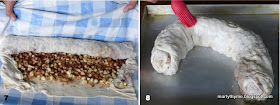| APPLE STRUDEL. |
| Robuchon and the Fan's Right Ear |
Strudel must be made with bread flour, says Larousse, because the dough needs to be stretched into a thin sheet and only a strong flour will allow that. I wondered about the vinegar in the dough. There are recipes that don't contain vinegar and other that do but I can't find an explanation for why the ingredient is included. Usually there would also be bicarbonate of soda and the two would react to give lift as in certain cakes and breads. If anyone can help me on this, I would be most grateful. Perhaps I should email Monsieur Robuchon and ask him since we've become ;-D great chums...
Larousse Gastronomique, while encyclopedic in nature, doesn't often give detailed recipe instructions. It must be assumed that readers will already be familiar with cooking concepts and methods. Anyway, more information would make the book even thicker and heavier! I've laid out the strudel recipe in customary format for ease of reading, but have adapted the recipe from Larousse and elaborated on the method after reading up on strudel-making.
Site check: About.com has pictures on how to stretch the dough, and Diana's Kitchen has instructions without pictures, but with a good description of the process. Baking911 has recipes for several fillings and suggests holding a "strudel bee": get some friends over to help with stretching the dough! I've tried to record each step in pictures myself.
APPLE STRUDEL
Adapted from Larousse Gastronomique
Serves 8-10
Serves 8-10
Dough
250g strong plain (bread) flour
150ml tepid water
Pinch of salt
1 teaspoon vinegar
1 egg yolk
1 tablespoon oil
(A)
200g dried fruit (raisins, chopped dates and crystallised ginger)
1 tablespoon rum (optional)
1kg cooking apples
3 tablespoons caster sugar
75 melted butter, plus extra for brushing
A handful of breadcrumbs
100g chopped walnuts
(B) – combined
2 tablespoons milk
Icing sugar for dusting
(B) – combined
2 teaspoon cinnamon
8 tablespoons soft brown sugar
8 tablespoons soft brown sugar
- Place flour in the bowl of an electric mixer; add the rest of the dough ingredients. Mix with a wooden spoon until the dough comes together. Using the mixer's dough hook, knead until the dough is smooth and elastic (Pix 1) but still tacky (Pix 2), about 8 minutes. Scoop up into a small bowl, cover with cling film and leave for 1 hour at room temperature, then place in the fridge overnight. When ready to make strudel, remove dough from fridge and allow to come to room temperature, about 1 hour.
- Combine the dried fruit with the rum, if using; set aside for 30 minutes. Peel and finely dice the apples; sprinkle with caster sugar. Mix dried fruit and apples together.
- Spread a large floured tea towel or sheet on a large table you can walk around; place the dough on it. Flour a rolling pin and roll out the dough into a rough rectangle (Pix 3). Flour the back of your hands, make fists and place them under the sheet of dough. Stretch the dough carefully using your knuckles (Pix 4), pulling your hands gently apart. Move around the table to work from all sides. Brush with extra melted butter, then keep on stretching it until it is very thin, taking care not to tear it; you should be able to see through the dough. Trim the edges to the shape of a large even rectangle (Pix 5). Use the trimmings to make a another, smaller strudel.
- Lightly brown the breadcrumbs and walnuts in 75g melted butter; spread this mixture evenly over the dough. Sprinkle with the fruit (try not to include too much liquid), then dust with the cinnamon-sugar mixture (Pix 6). Fold the two outer sides in, then, using the tea towel/sheet, roll up the dough carefully to enclose all the ingredients (Pix 7). Slide the strudel on to a buttered baking sheet. Brush with the milk (Pix 8). It's all right if the strudel does not lie straight; it can be curled to fit the tray.
- Cook in a preheated oven at 200°C for 40-45 minutes. When golden, take it out of the oven, dust with icing sugar and serve lukewarm.










